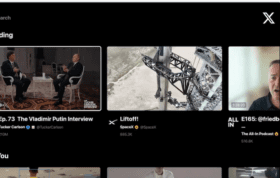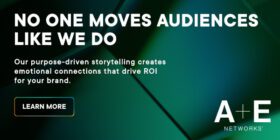By David Teich, editor of Cynopsis Digital
 As you may have noticed, the U.S. is in the midst of a presidential election. The next phase of the race kicks off today, with Day One of the Republican National Convention. The Democratic National Convention follows next week. So here we are: It’s down to two major party candidates, and whatever happens, the result will be historic. Either the first female president in American history will take office, or…well, the other likely outcome would also be highly original.
As you may have noticed, the U.S. is in the midst of a presidential election. The next phase of the race kicks off today, with Day One of the Republican National Convention. The Democratic National Convention follows next week. So here we are: It’s down to two major party candidates, and whatever happens, the result will be historic. Either the first female president in American history will take office, or…well, the other likely outcome would also be highly original.
And there’s another area in which the 2016 election season will dive into unprecedented territory: advertising. Using new and improved digital platforms, as well as increasingly-sophisticated data-gathering and audience-targeting tools, campaign advertisers and agencies are reaching audience segments both more precisely and on a wider scale than has ever before been possible.
First things first: A lot of money will be spent on political advertising in 2016. (Indeed, a lot already has been spent.) According to a projection from Nomura analyst Anthony DiClemente, total 2016 campaign spend will ultimately clock in at about $10.1 billion, up from $8.8 billion in 2012. Not surprisingly, over two thirds of that money will go to TV. But for the first time, over a billion dollars will go to digital. By comparison, the digital total was $159 million in 2012, and $22 million in 2008. That’s some yuge – and rapid – growth. New digital platforms, devices, and media outlets are cropping up by the day. Meanwhile, many of the platforms that have been around for a while have only become more useful to advertisers.
 Taken together, Facebook and Alphabet (Google’s parent company) will gobble up a hefty majority of digital campaign ad dollars this year. There are many reasons why, starting with the obvious one: reach. According to Google, YouTube has over a billion monthly users, up from about 800 million in 2012. Around 200 million for those users are in the U.S. And they spend hundreds of millions hours a day watching video. (To quantify that, one million hours is 114 years.) When you factor in Google’s search and display inventory, you’re talking about near-ubiquitous advertising reach across desktop and mobile. And Google’s DoubleClick suite of programmatic buying exchanges has only become more sophisticated over the years, using demographics, user interests, and other data to segment audiences more precisely.
Taken together, Facebook and Alphabet (Google’s parent company) will gobble up a hefty majority of digital campaign ad dollars this year. There are many reasons why, starting with the obvious one: reach. According to Google, YouTube has over a billion monthly users, up from about 800 million in 2012. Around 200 million for those users are in the U.S. And they spend hundreds of millions hours a day watching video. (To quantify that, one million hours is 114 years.) When you factor in Google’s search and display inventory, you’re talking about near-ubiquitous advertising reach across desktop and mobile. And Google’s DoubleClick suite of programmatic buying exchanges has only become more sophisticated over the years, using demographics, user interests, and other data to segment audiences more precisely.
Speaking of which, there’s been a major change since last election cycle: In September 2015, YouTube’s “TrueView” pre-roll inventory was made available programmatically for the first time, when it was added to Google’s DoubleClick Bid Manager (DBM). Google says that, since then, programmatic buying on YouTube has grown at a staggering month-over-month rate of 55%. “A political campaign always wants to deliver the right message to the right person at the right time,” says Charles Scrase, who heads up Google’s Government and Advocacy ad sales as Industry Director. “Google provides a whole suite of solutions for any advertiser to do just that.” A lot of political ad buyers feel the same way, and Alphabet will earn $400 million in political ad dollars in 2016, according to Nomura. A majority of the money will come from video inventory, and the rest from display and search.
 Facebook, likewise, boasts mind-boggling reach. The social network has over 1.6 billion users, and an estimated 160 million Americans will use it this year. And like YouTube, Facebook has become a powerful tool for political advertisers. Perhaps more than any other digital ad platform, Facebook makes it easy for advertisers to zero in on audiences with precision and granularity, allowing buyers to target audiences based on interests, age, gender, location, and other info. (And don’t forget, advertisers can also use Facebook’s ad-targeting abilities to buy Instagram. Inventory.)
Facebook, likewise, boasts mind-boggling reach. The social network has over 1.6 billion users, and an estimated 160 million Americans will use it this year. And like YouTube, Facebook has become a powerful tool for political advertisers. Perhaps more than any other digital ad platform, Facebook makes it easy for advertisers to zero in on audiences with precision and granularity, allowing buyers to target audiences based on interests, age, gender, location, and other info. (And don’t forget, advertisers can also use Facebook’s ad-targeting abilities to buy Instagram. Inventory.)
“In the last couple of years, Facebook has changed a lot about the way you can buy on their platform,” explains Nathaniel Kronisch, CEO of Buying Time Digital, a full-service media planning and buying agency based in Washintgon, D.C. “You’re not really just buying video and display ads now; you’re buying the ability to target specific audiences, and to work with Facebook on reach and frequency buys.” About that last part: Facebook introduced reach and frequency buying abilities in 2014. In this context, Reach refers to the number of unique individuals reached by an ad buy. Frequency refers to the actual number of times each person is reached by the ad. Traditional media platforms, such as print and TV, tend to allow for the customization of reach and frequency goals in ad buys. But historically, that capability has been rare on digital platforms. Essentially, the Facebook feature allows advertisers to customize where their ad dollars are going – either toward more reach (i.e., targeting more people) or more frequency (increasing the number of impressions that an audience sees).
For campaign advertisers, nailing down both optimal frequency and optimal reach is a tough but important balancing act. Any campaign advertiser can tell you that audiences must hear a campaign’s message repeatedly before there’s any hope of persuasion. But that doesn’t mean those audiences should literally keep seeing the same ad; such an experience can actually be off-putting. (More on that later.) Suffice to say, the ability to reach your intended targets without going into overkill mode is invaluable for political advertisers; Facebook is making it possible on a digital platform. All told, Nomura projects that Facebook will earn $350 million from political ads in 2016; most of it will come from social ads, and the rest from video.
Snapchat is another platform to look at, though at the moment it’s a tiny drop in the advertising bucket compared to Facebook and Google. (Nomura doesn’t have a 2016 projection for Snapchat; it falls somewhere in the “other” category, while Yahoo, Twitter and Pandora all outpace it.) But then, Snapchat’s advertising operation is still in its infancy. Indeed, only last month did the company introduce video ads to “Stories,” the most popular section of the app. Before that, ad inventory had been available only for Discover, the app’s platform for publisher-controlled channels.
“It’s the first chat platform to offer political advertising,” explains Kronisch. That’s a very big deal – and so, potentially, is Snapchat’s vertical video ad format, which takes up an entire phone screen and offer 100% viewability.
Oh, and there’s also this: According to comScore data from September, Snapchat has 150 million daily active users, 76% of who whom are millennials. And according to data that Snapchat provided to Politico last year, two thirds of those millennials are likely to vote. Younger demos are also good for something aside from voting: They’re the most actively engaged social media users, and they therefore have an outsized impact on public discourse and the tenor of news coverage.
“This is the election for millennials,” says Boris Gartner, the President and Chief Operating Officer of Fusion. “This is the election for the digital-first kids that are just going to be eligible to vote, and are very engaged in the political conversation.” Fusion, a multi-platform media company owned by Univision Communications, does have its own cable network. But that doesn’t mean political advertising will land harder there than it does on Fusion’s website, or on its Snapchat Discover channel. “If you’re not reaching young millennials with a thirty second spot on a [TV] channel, you need need to start trying to reach them on the platforms where they are,” says Gartner.
FYI, this is just as important for publishers as it is for advertisers. If you cover political campaigns in a way that reaches all the demos that might potentially be interested in the subject matter, you’ll get more ad dollars. CNN’s election coverage, for instance, lives on linear TV, but also on a variety of digital platforms, including a Snapchat Discover channel, a politics newsletter, Facebook, and CNN.com. “Our election packages vary in size – and they are truly cross-platform,” says Katrina Cukaj, who heads up CNN’s ad sales as EVP of Portfolio Sales & Client Partnerships for Turner Ad Sales.
One of the major reasons that digital inventory is becoming more sought-after is that mobile consumption has skyrocketed in the past few years. For instance, most of Facebook’s video views come from mobile, as do most of its ad sales. And YouTube has said that mobile users are significantly more likely to share its ads. “In 2012, about 10 or 20% of all online videos were viewed on mobile devices,” says Michael Balabanov, AOL’s Account Director overseeing U.S. political and advocacy advertising. This year, it’s close to 50%. And that, of course, has driven a major uptick in overall video consumption.
Mobile advertising provides campaigns with some unique opportunities. Have you heard the saying “all politics is local”? That’s because it mostly is. (National TV buys make up a tiny percentage of campaign spends, even at the presidential level.) Mobile platforms allow advertisers to make precise use of location-based data, targeting persuadable voters with issues specific to a location or community. In addition, sophisticated marketers can use “geo-fencing” technology to capture unique device IDs. So, for instance, if a campaign captures the device IDs of all the attendees at one of its rallies, it can later target those same phones with ads and campaign messages.
“We literally are carrying these screens around all day long,” said Ariel Deitz, AOL’s Mobile Sales Director, in a March conversation with Cynopsis Digital. Bernie Sanders had just defeated Hillary Clinton in the Michigan Democratic primary – a major upset. Among other efforts, the Sanders campaign and its digital agency, Revolution Messaging, had run mobile ads directed at a younger demo. (The ad campaign was run by AOL.) “There’s also no platform other than mobile where you can potentially reach your voter so many times a day – and where you can highly engage with them in a real estate that’s not competitive, where they’re not being served multiple ads on a screen at the same time,” Deitz said.
As political advertisers and creatives continue to habituate to digital platforms, they’re also getting better at making digital-first ad content. “What I saw in the past was people taking their made-for-TV creative and putting it on video platforms and networks,” says Scrase. “Now we’re finally seeing campaigns that are designing creative for video mediums.”
Still, not all political campaigns have caught up to the digital advertising revolution. “Maybe 10% of the money is going to digital now,” says Joe Fuld, President of the full-service political consulting firm The Campaign Workshop. “And in a presidential campaign, where over time you’re spending as much as a billion dollars, that can be a lot. But in a smaller campaign, it’s not very much.”
Of course, no one is arguing that political advertisers should prioritize digital spend over TV spend. The key, rather, is to combine TV and digital. “It’s really one plus one equals three when you’re looking at TV plus digital,” says Ted Gurley, VP of Digital Sales at Univision Communications. “You’re able to reach the broad group with TV, and [with digital] you’re able to tailor-make an ad that may really play to their special needs, concerns or interests of specific individuals.”
In addition to new and evolving digital platforms, data science has taken on an increasingly prominent roll in campaign advertising. Data and targeting may be important for advertisers across the board, but it may be especially so in political campaigns. After all, the goal is to zero in on a highly precise subset of individuals: namely, those whose voting behavior can still be influenced. Fortunately for people working in the political advertising space, there’s a lot of data to be found, both first and third party. Voter data, location-based data, voter history, demographics, direct mail and email responses, and much more can be thrown into the pot. Agencies and campaigns will often create custom model data matched to a voter file and/or other info. The more granular the data, and the more data there is that can be layered on top of other data, the more precisely advertisers can reach their targets.
The 2012 Presidential race was massively influential in this area. After the election, the media caught wind of the “Optimizer,” a tool that the Obama campaign had used to hyper-target its TV advertising. In addition to using Nielsen Media Research data, the Optimizer ingested data from every voter the campaign had come in contact with; volunteer files, voter files, email lists, the campaign’s Facebook audience and Twitter followers, and so on. The campaign then took that data, as well as publicly available data about registered voters, and cross-referenced it against Rentrak set-top box data. And with Rentrak’s help, the campaign’s advertising then targeted programs that voters – particularly persuadable voters – were frequenting. “Big data and data science have been around since well before 2012,” says Kronisch. “What made the Optimizer interesting was there were a lot of headlines and a lot of press. And because Obama was so successful, a lot of Republican and Democratic consultants are starting to embrace data in ways that they hadn’t before 2012.”
“In 2012, only Obama used political segments paired with TV data, but now everyone does that,” says Carol Davidsen, VP of Political Technology at comScore (formerly Rentrak). Davidsen should know: She served as Director of Integration and Media Analytics on Obama’s 2012 campaign. But to her mind, even four years later, many on both the buy and sell sides are still figuring out the best practices.
For one thing, Davidsen says that buyers should try to avoid making decisions based on average frequency of ad exposure – though she concedes that’s not always possible to do. “Average is a very dangerous number,” she says. “One person can have twelve of something, and another person can have two. We can say the average is seven, but that doesn’t actually tell us the story.” Davidsen says that advertisers should set their sites on true, unduplicated frequency whenever they can. And she says that only by collecting extremely granular data can true frequency be measured.
When it comes to measuring overall cross-platform data, even the most sophisticated campaign advertisers are lacking. For instance, to measure cross-platform frequency, campaigns tend to rely on algorithms, surveys, questionnaires, and the like. But there’s no concrete data source to tell them what frequency looks like across all platforms. “You might have a survey telling you that 18-year-olds spend more time on these devices than those devices,” says Davidsen. “But there’s nothing based off of real, true data.” For instance, if a household viewed an ad four times on TV and two times on a digital platform, that’s the kind of thing a campaign or agency would really want to know about. By 2018 or 2020, Davidsen thinks this kind of data may be available. Indeed, this is exactly the kind of problem that comScore and Rentrak hoped to tackle when they merged.
Another major trend to look out for – which this article touched on earlier – is programmatic buying. Google is hardly the only platform offering programmatic marketplaces. Indeed, use of programmatic platforms and vendors is growing steadily. For instance, Bernie Sanders and Ted Cruz both made significant use of programmatic buys during this year’s primaries. Numerous political digital ad consultancies, including CampaignGrid, Targeted Victory, DSPolitical and Rocket Fuel are now offering self-serve programmatic buying platforms. Those kinds of platforms have really only been widely used since 2014.
As Ad Age pointed out last month, such consultancies have been snatching up inventory – early – to be sold programmatically. So why the big push? The appeal is fairly straightforward: In a political campaign, sophisticated digital targeting requires boatloads of data, as well as the ability to make quick and effective use of it. So in the digital marketplace, with numerous possible digital platforms to run ads on, a cross-platform strategy would seem to benefit greatly from automated buying. “One of the biggest responsibilities of a digital campaign is to efficiently leverage third-party data – say, from a political data company – and then find the right audience at scale, and do it efficiently and effectively,” says JC Medici, Rocket Fuel’s National Director of Politics and Advocacy.
Using data to run digital campaigns efficiently, effectively, and at scale: That’s programmatic in a nutshell – when it’s working well. Though to hear Medici tell it, some programmatic platforms will err by serving the same ad impressions to the same individuals repeatedly, instead of serving ads only to the right people at the right times. As discussed up top, that’s a big no-no in political advertising. “What if an ad for an office chair stalks you for six months?” Medici says. “The first couple days, that’s effective advertising. But after a while it turns into a nuisance, and you’re turned off about it.” It could easily be the same story with a viewer’s voter intent, he says.
Even after the decisions are made and the ads run, there’s one important lingering question: Is there data that can tell you whether your spend is working? Yes and no. You can look at digital metrics such as video completion rate, social shares, click-throughs, and time spent. But in end, the best measurement comes from the political campaign itself. “You look at whether they got success with what they were trying to achieve,” says Univision’s Ted Gurley, who works closely with political campaigns. “A higher position in the polls, meeting or exceeding their donation goals.” What’s impossible – or, at least, is impossible at the moment – is to track exactly what individuals did in the voting booth. “So you look at the digital engagement,” says Gurley. “You look at the lift, at the polling numbers, the donations.”
That, of course, is why campaigns have been reliant on television for so long: They’ve seen it move poll numbers, drive donations, the whole bit. But if digital can do the same things, you can bet that campaign advertisers will keep investing more money in the space. “If folks feel like the polls are changing favorably because of a digital buy, they’re going to spend more money doing digital,” says The Campaign Workshop’s Joe Fuld. “Gone are the days when a political campaign can rely on one medium only. A political campaign can’t be singularly reliant on television and feel they’re reaching people.”
The Facebooks, YouTubes and Snapchats of the world – not to mention the Fusions and CNNs – have much to offer political advertisers. But no one can say, as a matter of objective fact, which digital platforms are the “best” ones to advertise on. The ideal digital ad strategy – whatever it may be – is always dependent on factors unique to an individual campaign. Usually, it’s wisest to target multiple platforms, especially if you’ve got a lot of data. “One interesting thing doesn’t do it,” says Davidsen. “It’s a combination of things, and that combination varies from person to person. The more data that’s coming into the system and getting integrated, the more you can do custom outreach plans to individuals, and get the right blend of buys in.”
Advertising, of course, isn’t the end-all-be-all. There are countless other avenues by which political campaigns attempt to move the needle. Heck, during the primaries, Jeb Bush’s $130 million in ad spending proved no match for Donald Trump’s Twitter account. “Advertising plays a huge part because it can really swing that last point five percent of the vote,” says Davidsen. “But there are a lot of other factors that come into play.”
Cynsiders columns live on Cynopsis’ main page and are promoted across all daily newsletters. We welcome readers’ comments, queries, and column ideas at [email protected].





